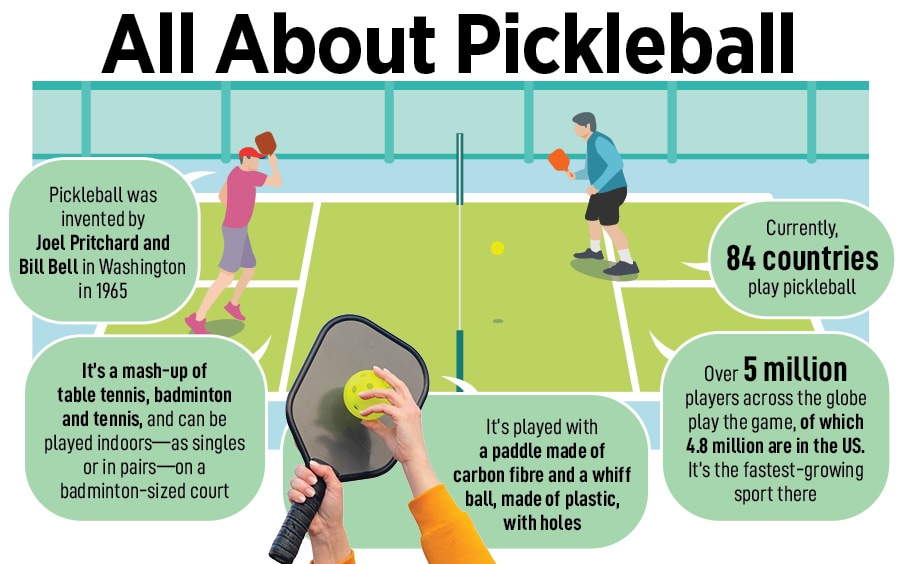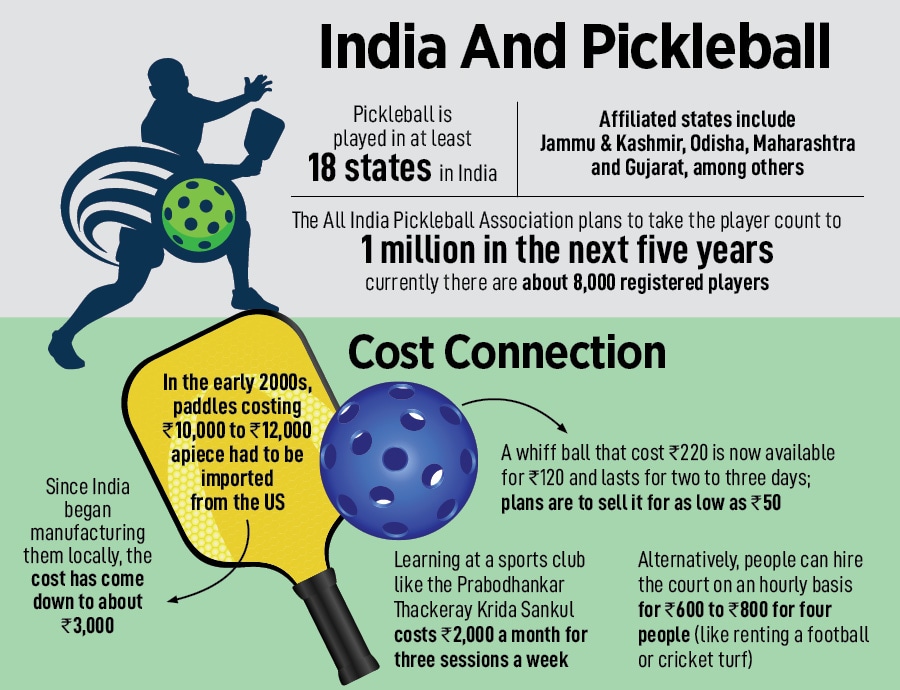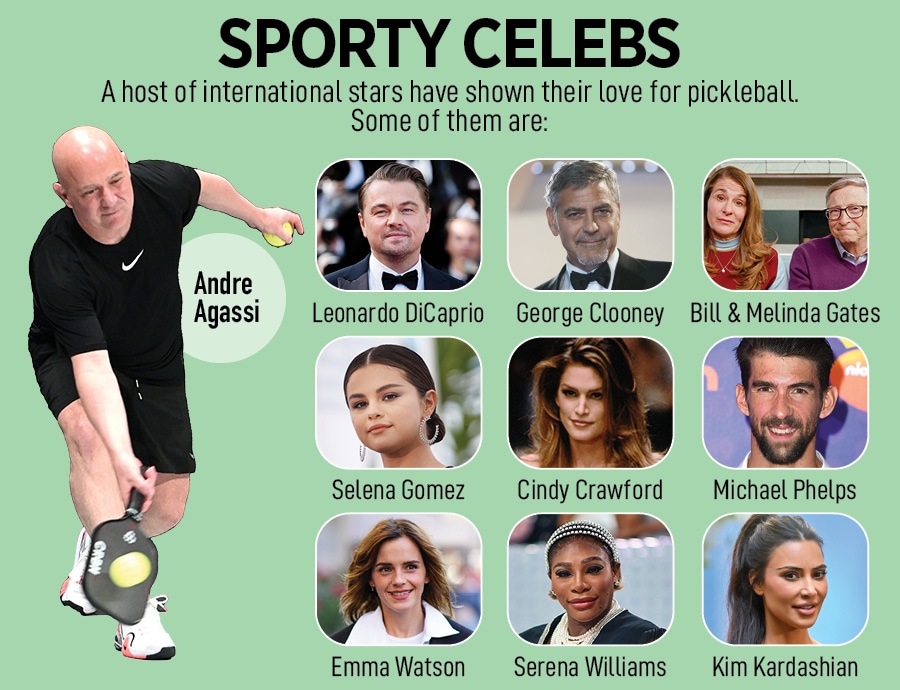The coach nods in approval. At the court next to it, a group of youngsters warm up for their training session while two boys begin practising their backhand strokes.
A racquet sport that combines elements of tennis, table tennis and badminton, pickleball is growing in popularity across the country. People from the age of eight to 80 are playing the game—either for recreation, some sort of exercise or professionally—that was originally invented in 1965 in the US. In India, many discovered pickleball mostly during the Covid-19 pandemic as a non-contactable sport with health benefits, but the first efforts to introduce the game in the country began in the late 2000s. At the forefront of it all was Sunil Valavalkar, founder-director of the All India Pickleball Association (AIPA).
Valavalkar’s first brush with the sport was in 1999 when he went to Canada as a project supervisor for the Indian government’s non-formal-educational youth programme. For over three months then, he lived with sports aficionado Barry Mainsfield, who played tennis in the morning, badminton in the afternoon and pickleball on the roads in the evening, “often lifting the net for the cars to go by". “I played pickleball there, and returned to India in January 2000, but I forgot about the game. It was like another sport for me," recalls Valavalkar, 59, who began playing tennis at the age of 40, got into sports administration in 2007, and is now wholetime director with GTL, an infrastructure services company focussed on telecom.
It was in 2006 when he went to Cincinnati in the US for a tennis clinic that he saw the close relation between the two sports, and decided to “bring pickleball to India". On his return, he got four racquets, called paddles, and eight wiffle balls—plastic ones with holes that you play the game with—with the sole intention of giving a demo.
His guinea pigs were his 10-year-old daughter and eight-year-old niece. He tried showing the game everywhere—in parks, building compounds, on the streets—and to anyone he knew, but he was only mocked and ridiculed. The sound of the ball hitting the wooden paddles then, unlike the ones made of carbon fibre today, did not infuse confidence among his audience. In fact, it irritated all and sundry. When he showed how pickleball is played to some of his co-tennis players, they found it blasphemous that he was doing it on their court.
Tennis player Anil Vyas assured him that the game will click in India and that gave Valavalkar some hope. That was 2008 and by then Valavalkar had begun loving the sport so much that he had made it a mission to take the game to the grassroots. So, he formed AIPA that year, made visiting cards and a letterhead for the association to give it legitimacy. When he began approaching schools, colleges and sports clubs thereafter, he says, people at least began to lend a patient ear.
![]()
A demonstration to the National Cadet Corps students of Patkar College in Mumbai’s Goregaon yielded results, as they formed a group of 15 pickleball players. Valavalkar gave another glimpse of the game during a festival organised by The Times of India in 2008, and claims the word ‘pickleball’ appeared for the first time in the broadsheet the same year. “Organically, things moved ahead," he says.
The progress was slow, but Valavalkar, who played kabaddi and kho kho in school and college, was relentless in his efforts to promote the game. “In 2013, I began organising national tournaments, and this went on till 2018. Amid this, I toured a few states such as Rajasthan, Karnataka and Bihar, and formed their pickleball associations," he says. “Additionally, I travelled across Maharashtra extensively—from Thane to Gadchiroli and Kolhapur to Pandharpur. In Dhule, for instance, I organised a state-wide pickleball camp. I successfully began replicating the structure in other states."
Also read: From handball to panja, why sports leagues are taking off in India
![]()
Visionary push
The real push, though, concedes Valavalkar, came when he approached Arvind Prabhoo, chairman of PTKS. “Prabhoo came with exemplary vision, extensive resources, and a vast pool of knowledge—he has been in sports administration for 25 years," he says.
“When Sunil introduced me to the game in 2017, and I saw it, I realised it’s a game for the future," says Prabhoo, 55, who’s now president of the International Pickleball Federation. The reason for that belief, he adds, was because Indians are extremely good at wrist games and racquet sports. “And pickleball is an easy game to adapt to."
Merely talking about the sport was not enough. Prabhoo felt they must get people to play pickleball if they wanted to take the game to every nook and corner of the country. So, in 2018, he organised a local tournament in Mumbai where 64 players (32 teams) turned up. Enthused by the response, Prabhoo held an inaugural ranking tournament in Balewadi, Pune, that saw 250 participants from 17 states. “In two days, we played over 1,000 matches," says Valavalkar. “The second edition of the tournament in Palawa, Dombivli, in 2021 saw the participation of 19 states and we staged 1,300 matches then."
The interest in pickleball was gradually building, but there were challenges galore. Among the biggest was the cost of the equipment. In the initial days, for instance, a paddle from the US would cost Rs10,000 to Rs12,000, and a whiff ball Rs220. Since companies in India began manufacturing them, the price has reduced to Rs3,000 for a paddle and Rs120 for a ball.
“The equipment was a big hurdle. One of our trustees [Ymak] decided to manufacture it here the raw material though comes from China. It’s sold at a subsidised cost, and we save on import duty," explains Prabhoo, who, after noticing a positive response to the kit, decided to go all-out in organising periodic tournaments, almost every month. The enthusiasm at these events prompted other states to copy the formula.
![]()
As the tournaments became bigger, the budgets also shot up: From Rs 18-20 lakh to Rs 25 lakh. In 2022, the Bainbridge Cup—the World Cup of pickleball—was held at the National Sports Club of India in Worli, Mumbai, in which over 450 players from 12 countries participated, and 1,500 matches were played over five days. “The prize money for that event was $50,500 [Rs40 lakh-plus]. That was unheard of," says Prabhoo, a former patron of Indian women’s cricket from 2001 to 2007, and someone who played table tennis and badminton in school and college. “We positioned it as a lifestyle game that’s being played by the who’s who. Although players emerge from the grassroots, the positioning of the game has to have an aspirational value. That’s how you draw youngsters to the sport. The budget was Rs 2 crore. And Team India won the title by beating a US team. The shock value of the win helped people here take notice of the sport even more."
One such emerging player from that tournament was Mayur Patil, who will be among the six Indians representing India at the English Open, scheduled to be held in August. The 24-year-old from Chopda, a small town in Jalgaon, Maharashtra, won a silver in the open category in the Bainbridge Cup. He plans to replicate that success in the UK. “Our first goal is to win a medal for the country, and then focus on individual events. I’d like to share my experience with fellow players here once I return, especially if we learn new techniques," says Patil, who began playing pickleball in 2015. “It’s a racquet sport and it has less chances of injury. It was easier for me to learn the game as I used to play table tennis and badminton. It’s a lot of fun, it’s an addiction. Pickleball is easy to learn, but hard to master," says Patil, whose father is a farmer and mother a housewife.
Valavalkar and Prabhoo hope that many more Indian players like him flourish. And they are leaving no stone unturned to ensure that the remotest areas have the right infrastructure to produce sporting talent.
![]()
India plays pickleball
Sneh Giri grew up in Jharkhand, and moved to the US in 2008. The strategy consultant with a multinational firm began playing pickleball when he was in Chicago in 2020. Since he was planning a vacation to India at that time, he decided to read up about the sport in the country and got to know of Valavalkar. The two got in touch on Facebook and met in Thane when the AIPA founder-president encouraged him to promote the sport in Dhanbad. Gaurav Kumar, a local, was already into organising pickleball games there, but the setup was largely unorganised.
So, Giri suggested they host a tournament and decided to sponsor it. The Jharkhand Association Pickleball Tournament was held in July with 45 players taking part. “One had to walk over beer bottles and garbage to reach the pickleball court in Jharia, a neighbourhood in Dhanbad… it was like a waste disposal area. And none of the players could speak a line of English the maximum salary they earn there is Rs 7,000 to Rs 8,000, and they run their homes with that. It’s a super struggle," says Giri, who is now trying to raise funds for them with the help of his NRI friends.
![]()
“In India, this sport is picking up, but it’s slow. The game has a future no matter where you play," he explains, acknowledging that there’s still a lot of work that needs to be done. “My immediate priority is to arrange funding for four pickleball players from Jharkhand so that they can go to places like Mumbai, Goa, Bangkok and play tournaments. Also, I feel Indians who play pickleball in the US should be onboarded as AIPA members," says Giri, adding that he’s spoken to the mayor of Dhanbad who has promised to create four world-class pickleball courts in Dhanbad.
Similarly, it was during the pandemic that Jacob Bijo Daniel discovered pickleball. He was looking for something that his children could play since they were stuck indoors when he came across the game. The resident of Mavelikkara in Kerala’s Alappuzha district bought some paddles and began playing the sport, assuming that it was new in India.
He was pleasantly surprised to know what Valavalkar had done and felt that the game needs to be popularised in the state. “I was in the dark… I was not aware that so much had been done for the sport in India. Sunil was my guiding star. He was a fatherly figure who gave me all the leads," says Daniel, who, along with his wife and two children, participated in the Bainbridge Cup in all categories—singles, doubles and mixed doubles.
![]()
Now, as president of the Federation of Pickleball Association of Kerala (FPAK), he plans to take the sport to schoolchildren. “We plan to have a state-wide tournament in three months," says the agricultural engineer, who used to work in the private sector in the Middle East. Now, he and his wife, who is secretary of FPAK and an agricultural engineer, have decided to concentrate on popularising various non-conventional racket games.
In Goa, former under-25 cricketer Manoj Patil is looking at the game from a tourism and industry perspective as well. The president of the Goa Pickleball Association held a national ranking tournament in Madgaon last month where 250 players from 17 states vied for the top honours over three days.
Prior to that, demo sessions were held in North and South Goa for physical education teachers of various schools in the state. “We also invited the hospitality sector and housing societies to participate in them because the goal is to make Goa the pickleball hub of India," says Manoj Patil, who got hooked on to the game after watching it on YouTube. “I realised how big the sport is and how global it can become."
![]()
A similar clinic was held for referees too and that saw participation from industry representatives too. “We want to take the sport to the grassroots by promoting it in schools. We also want to push housing societies to have courts. And nine hotels such as the Taj and Novotel have expressed interest in setting up pickleball courts," he adds. “In November, we plan to have a big celebrity event. We are looking at how Goa can get better footfalls in terms of high-spending tourists."
Ambitious plans
Prabhoo knows that the needle has just about moved. For the sport to make a real and meaningful impact, he’ll need support from the bigwigs. “In India, if I need to spread the game, I need very deep pockets. And it has to be a corporate with a deep vision to promote it at the grassroots level. Every kid who comes needs to have a paddle in their hand," he says. Valavalkar reveals that corporates are approaching them, and many big industry houses have evinced interest in promoting the sport that is not only seen as affordable but also good for one’s overall health. “We’ll bring pickleball as a strong alternative. And we’ll change people’s outlook toward playing sport," he insists.
Agrees Prabhoo: “It"s a recreational sport that’s great for your heart, a good aerobic exercise and ideal for weight loss."
![]()
There are plans to start a pickleball league on the lines of the Indian Premier League. A formal announcement is likely to be made in November. And Prabhoo, who is wheelchair-bound following a car accident over three decades ago, is in no mood to stop. More than 80 countries play pickleball currently. “I want to take the sport to another 80 nations. For that, I have created a $50,000 [over Rs 40 lakh] fund. All this is self-funded as of now… we are looking for investors. The Olympics is the ultimate aim," says Prabhoo. “Pickleball is a relatively new game. We can give it any direction we want and take it to a level which is next to cricket."









